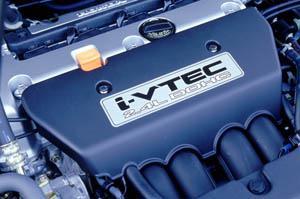Although automotive technology may often seem stale, it often takes a major or revolutionary change to make a difference in a field that has grown so large. Although not recent, perhaps one of the most innovative and intelligent ideas to come out of car engine technology can be found in the form of the Honda Motor Company’s VTEC engine.
Many may have heard the phrase “VTEC” associated with import cars or those who care about performance in their vehicles. However, even many who do have a Honda or Acura with a VTEC engine may be unaware of how it actually works.
Before diving right into explaining the VTEC though, a little discussion is probably necessary on the some of the basics of how a normal engine works. An engine creates combustion by letting fuel and air into the cylinders and then “sparking” it, or creating a small explosion. These explosions are what drive the vehicle, enabling the car to put power to the wheels. However, there are a wide variety of factors that influence how quickly the engine creates combustion and also how quickly it expels the exhaust waste that is created. One of the most important factors, though, are the engine valves. The valves on an engine are the principle parts that allow air to enter the engine, and are responsible for releasing exhaust. If the valves are not opened and closed in a certain way, an engine becomes completely useless. Thus, a camshaft is used to open and close the valves. How does that happen? Well, a camshaft has a number of lobes on it, when rotated, these lobes push or hit against the valves, thus opening and closing them in a certain order.
Camshafts are incredibly important to engines, and especially for running an engine at the correct ranges and speeds. To simplify a bit, a camshaft is usually designed with a “profile” in mind. This entails the range in which the car is designed to run the best or with the most power. One car may be equipped with a low rpm camshaft, for instance, which is designed to function best when the engine is running at a very low rotational rate. However, another car may have a camshaft which is designed to open and close the valves in rapid succession when running at a very high rpm. Herein we have one of the major factors in determining the performance of a vehicle. A car needs an entirely different camshaft profile to effectively run at both high and low speeds. Perhaps one can now see why it is almost impossible for a car to perform perfectly both at lower speeds and still maintain good performance in the upper rpm ranges.
Honda, though, figured out a way for an engine to have multiple camshafts, and effectively switch them out as needed. They named the system, “VTEC”, and that word has become a legend to anyone interested in import vehicles and performance. The word stands for “Variable Valve Timing and Lift Electronic Control”.
The idea and concept behind a VTEC is actually a very simple one, to allow an engine to run at maximum efficiency through the entire RPM range, without weakness at one particular spot or range. While the idea may sound simple, accomplishing it is somewhat of a labor.
One can actually tell a VTEC simply by looking at the camshaft. Whereas most camshafts have small primary and secondary lobes with which to push on the valves, a close look at a VTEC camshaft reveals a bigger lobe centered between the two smaller, main lobes. At first, this idea may seem entirely confusing, and the idea of big central lobe may seem to complicate more than help, but with the proper system in place, that big lobe can make all the difference in the world.
The point at which the VTEC lobes begin to act on the engine is commonly referred to as “VTEC crossover”. This is nothing other than the point at which the system is engaged,
When a VTEC does kick in, a small hydraulic pin is pushed through the three separate lobes, in fact creating one large lobe designed to run at incredible effectiveness at high RPM. Usually the crossover point in a stock car is somewhere around 5,000 or 5,500 RPM. Although aftermarket products are sold which enable one to mess around with the point at which the VTEC is activated.
However, a VTEC does not just simply turn on, a variety of factors have to be properly read by the ECU and determined to be in the correct position before the system will work. Generally, a VTEC equipped car’s ECU will read oil pressure, which is of essential importance in the system, engine speed and rotation, position of the throttle, water temperature, and several other factors which may be different depending on which car is being analyzed.
Although the VTEC is a powerful system, recently, Honda engineers have come out with something which is called the “i-VTEC”. Although the i-VTEC is in fact very similar to the normal VTEC system, it acts to determine the proper opening and closing of the valves at nearly every level, instead of simply setting a crossover point. This enables a small, four cylinder engine to put out incredible power. In fact, the RSX Type-S, with only a 2.0 liter engine, produces nearly 205 horsepower.
A VTEC is a truly innovative and powerful idea, and although the system was not specifically created by Honda, one can now find it on many other makes of vehicles. Companies such as Toyota, Nissan, Mercedes, BMW and others have realized the incredible power advantage that an engine with variable valve timing brings with it.





